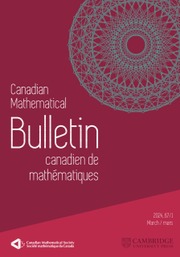Crossref Citations
This article has been cited by the following publications. This list is generated based on data provided by
Crossref.
Mielke, Alexander
2013.
Recent Trends in Dynamical Systems.
Vol. 35,
Issue. ,
p.
555.
Duong, Manh Hong
Peletier, Mark A.
and
Zimmer, Johannes
2014.
Conservative‐dissipative approximation schemes for a generalized Kramers equation.
Mathematical Methods in the Applied Sciences,
Vol. 37,
Issue. 16,
p.
2517.
Fuchs, Philipp
Jüngel, Ansgar
and
von Renesse, Max
2014.
On the Lagrangian structure of quantum fluid models.
Discrete & Continuous Dynamical Systems - A,
Vol. 34,
Issue. 4,
p.
1375.
Conforti, Giovanni
and
Pavon, Michele
2017.
Geometric Science of Information.
Vol. 10589,
Issue. ,
p.
91.
Fusca, Daniel
2017.
The Madelung transform as a momentum map.
Journal of Geometric Mechanics,
Vol. 9,
Issue. 2,
p.
157.
Khesin, Boris
Misiolek, Gerard
and
Modin, Klas
2018.
Geometric hydrodynamics via Madelung transform.
Proceedings of the National Academy of Sciences,
Vol. 115,
Issue. 24,
p.
6165.
Conforti, Giovanni
and
Pavon, Michele
2018.
Extremal flows in Wasserstein space.
Journal of Mathematical Physics,
Vol. 59,
Issue. 6,
Rosyid, M F
and
Wahyuningsih, K
2019.
Wasserstein space as state space of quantum mechanics and optimal transport.
Journal of Physics: Conference Series,
Vol. 1170,
Issue. ,
p.
012006.
Khesin, Boris
Misiołek, Gerard
and
Modin, Klas
2019.
Geometry of the Madelung Transform.
Archive for Rational Mechanics and Analysis,
Vol. 234,
Issue. 2,
p.
549.
Léger, Flavien
and
Li, Wuchen
2019.
Geometric Science of Information.
Vol. 11712,
Issue. ,
p.
733.
Konarovskyi, Vitalii
and
von Renesse, Max‐K.
2019.
Modified Massive Arratia Flow and Wasserstein Diffusion.
Communications on Pure and Applied Mathematics,
Vol. 72,
Issue. 4,
p.
764.
Conforti, Giovanni
2019.
A second order equation for Schrödinger bridges with applications to the hot gas experiment and entropic transportation cost.
Probability Theory and Related Fields,
Vol. 174,
Issue. 1-2,
p.
1.
Backhoff, Julio
Conforti, Giovanni
Gentil, Ivan
and
Léonard, Christian
2020.
The mean field Schrödinger problem: ergodic behavior, entropy estimates and functional inequalities.
Probability Theory and Related Fields,
Vol. 178,
Issue. 1-2,
p.
475.
Léger, Flavien
and
Li, Wuchen
2021.
Hopf–Cole transformation via generalized Schrödinger bridge problem.
Journal of Differential Equations,
Vol. 274,
Issue. ,
p.
788.
Beyer, Michael
and
Paul, Wolfgang
2021.
On the Stochastic Mechanics Foundation of Quantum Mechanics.
Universe,
Vol. 7,
Issue. 6,
p.
166.
Khesin, Boris
Misiołek, Gerard
and
Modin, Klas
2021.
Geometric hydrodynamics and infinite-dimensional Newton’s equations.
Bulletin of the American Mathematical Society,
Vol. 58,
Issue. 3,
p.
377.
Chen, Yongxin
Georgiou, Tryphon T.
and
Pavon, Michele
2021.
Stochastic Control Liaisons: Richard Sinkhorn Meets Gaspard Monge on a Schrödinger Bridge.
SIAM Review,
Vol. 63,
Issue. 2,
p.
249.
Chen, Yongxin
Georgiou, Tryphon
and
Pavon, Michele
2021.
Geometric Science of Information.
Vol. 12829,
Issue. ,
p.
860.
Cui, Jianbo
Dieci, Luca
and
Zhou, Haomin
2022.
Time discretizations of Wasserstein–Hamiltonian flows.
Mathematics of Computation,
Léonard, Christian
2022.
Feynman-Kac formula under a finite entropy condition.
Probability Theory and Related Fields,
Vol. 184,
Issue. 3-4,
p.
1029.
 $\nabla _{{\dot{\mu }}}^{\mathcal{W}}\,\dot{\mu }\,=\,-{{\nabla }^{\mathcal{W}}}\,F\left( \mu\right)$ on the space of probability measures, where derivatives are taken with respect to the Wasserstein Riemannian metric. Here the potential
$\nabla _{{\dot{\mu }}}^{\mathcal{W}}\,\dot{\mu }\,=\,-{{\nabla }^{\mathcal{W}}}\,F\left( \mu\right)$ on the space of probability measures, where derivatives are taken with respect to the Wasserstein Riemannian metric. Here the potential  $\mu \,\to \,F\left( \mu\right)$ is the sum of the total classical potential energy
$\mu \,\to \,F\left( \mu\right)$ is the sum of the total classical potential energy  $\left\langle V,\,\mu\right\rangle $ of the extended system and its Fisher information
$\left\langle V,\,\mu\right\rangle $ of the extended system and its Fisher information  $\frac{{{\hbar }^{2}}}{8}\,{{\int{\left| \nabla \,\text{1n}\,\mu\right|}}^{2}}\,d\mu $ . The precise relation is established via a well-known (Madelung) transform which is shown to be a symplectic submersion of the standard symplectic structure of complex valued functions into the canonical symplectic space over the Wasserstein space. All computations are conducted in the framework of Otto's formal Riemannian calculus for optimal transportation of probability measures.
$\frac{{{\hbar }^{2}}}{8}\,{{\int{\left| \nabla \,\text{1n}\,\mu\right|}}^{2}}\,d\mu $ . The precise relation is established via a well-known (Madelung) transform which is shown to be a symplectic submersion of the standard symplectic structure of complex valued functions into the canonical symplectic space over the Wasserstein space. All computations are conducted in the framework of Otto's formal Riemannian calculus for optimal transportation of probability measures.
